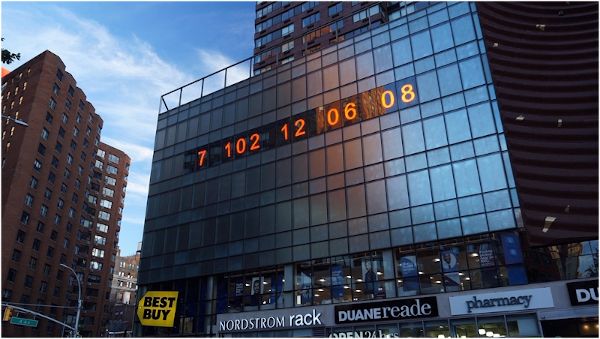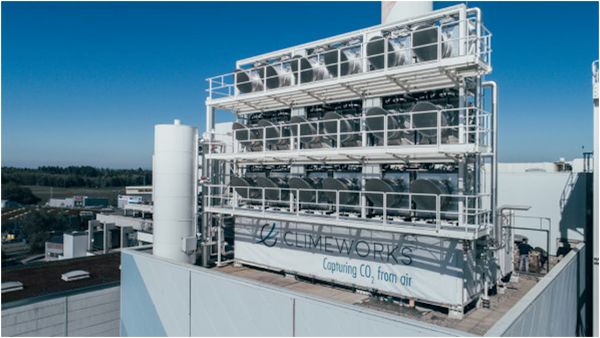
The Climate Clock [Source: 6sqft.com]
Charles Goulding Jr. examines the possibilities for use of 3D printing in carbon capture equipment.
A new clock in New York City’s Union Square counts down; currently, it shows just over seven years remaining.
That is the timeframe after which global temperature increases are expected to reach 1.5 degrees Celsius (above pre-industrial levels). Beyond that point, many effects of climate change are predicted to be irreversible when geological feedbacks kick in — effects that will include food shortages, droughts, mass migrations, extreme weather events, and catastrophic sea level rise. The clock’s unmistakable point is that we are in a climate emergency.
Put in terms of CO2, a 1.5 degree Celsius rise in global temperature corresponds to roughly 430 parts per million of atmospheric carbon. Yet despite greater public awareness about climate change and its perils, CO2 levels continue to rise.
Climate Capture and Sequestration: The Basics
Carbon capture and sequestration (CCS) seeks to remove carbon dioxide (CO2) and store it away. Consequently, CCS is known as a negative emissions technology.
CCS technologies capture CO2 from two locations:
- At major industrial sources of emission (point-source), and
- From the atmosphere itself (direct air capture)
Some major industrial sites and utilities already perform point-source CCS. Typically, exhaust gas flows through an absorption column, where a solvent absorbs the CO2.
In direct air capture (DAC), giant fans inhale large quantities of air. That air then typically passes over thin plastic surfaces while a specialized solution binds to CO2.

In either case, CO2 is then compressed into a liquid, transported to & pumped into geological formations, and solidified.
From Moonshot to Mandatory
Long considered a moonshot, direct air capture is now taken far more seriously. In 2009, Bill Gates gave DAC a high-profile boost by committing significant money. Two years ago, a Republican-led congress provided another boost when it added DAC to a carbon capture credit that reaches up to $50 per metric ton of CO2.
Nevertheless, all forms of CCS require major innovation to be viable at a mass scale. Consequently, former Energy Secretary Ernest Moniz recently proposed US$11 billion in CCS R&D funding over the next ten years, and already this year the DOE has committed US$72 million to related projects.
A 3DP Breakthrough in Carbon Capture
Given CCS’s expensive, often customized needs, 3D printing has an opportunity to be a climate hero. This August, the Department of Energy provided a stellar example when scientists at Oak Ridge National Laboratory (ORNL) designed a novel, circular device that cools absorption columns.
CO2 absorption isn’t perfect. The heat created causes solvent absorption to underperform. Cooling devices have long existed, but the unusual geometries of absorption columns present obstacles to implementation.
In her description of the novel device, lead investigator Xin Sun illustrated why 3D printing succeeded where conventional manufacturing had failed.
“Prior to the design of our 3D printed device, it was difficult to implement a heat exchanger concept into the CO2 absorption column because of the complex geometry of the column’s packing elements. With 3D printing, the mass exchanger and heat exchanger can co-exist within a single multifunctional, intensified device.”
Carbon Capture and 3D Printing: Opportunities Abound
The ORNL’s cooling device is a likely harbinger of things to come. Many aspects of CCS are well-suited to 3D printing. The following list includes some such technology:
- Heat exchangers
- Pumps
- Compressors
- Packing elements and membranes for absorption columns
- Transport piping, including fittings
- Air contactor components (DAC)
- Fan/Air capture components (DAC)
- Calciners and slaker systems (DAC)
- Materials innovations e.g. for solvents, concentration, purification, compression
- Alternate uses for compressed CO2, including cement mixers for making concrete
New avenues and product categories may likewise emerge due to 3D printing. Indeed, the ORNL’s heat exchanger is an addition to absorption columns, not a replacement for an existing device.
The Research & Development Tax Credit
Firms innovating in CCS can avail themselves of the federal R&D tax credit to help subsidize their research efforts.
Enacted in 1981, the now permanent Federal Research and Development (R&D) Tax Credit allows a credit that typically ranges from 4%-7% of eligible spending for new and improved products and processes. Qualified research must meet the following four criteria:
- Must be technological in nature
- Must be a component of the taxpayer’s business
- Must represent R&D in the experimental sense and generally includes all such costs related to the development or improvement of a product or process
- Must eliminate uncertainty through a process of experimentation that considers one or more alternatives
Eligible costs include U.S. employee wages, cost of supplies consumed in the R&D process, cost of pre-production testing, U.S. contract research expenses, and certain costs associated with developing a patent.
On December 18, 2015, President Obama signed the PATH Act, making the R&D Tax Credit permanent. Beginning in 2016, the R&D credit can be used to offset Alternative Minimum Tax for companies with revenue below $50MM and for the first time, pre-profitable and pre-revenue startup businesses can obtain up to $250,000 per year in payroll tax cash rebates.
Conclusion
As the clock ticks toward 430 CO2 parts per million, 3D printing has already made a major contribution to the elimination of greenhouse gas. Further innovation is doubtlessly on the way as both the US government and private firms seek to make CCS a contributing piece of the mosaic that successfully addresses climate change.
